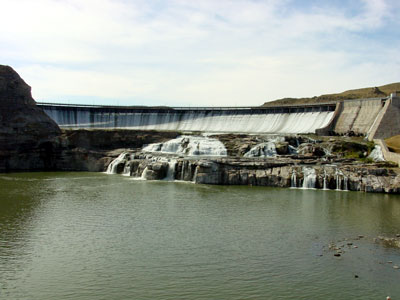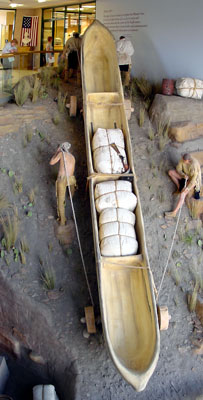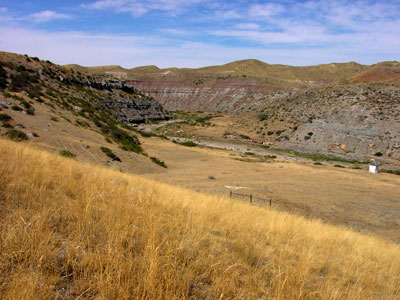
Getting Around the Great Falls
Aug. 24-25, 2003
After the confluence of the Missouri and Yellowstone Rivers, we headed for Great Falls, MT, with two stops on the way, one at the confluence of the Missouri and Marias rivers and one in Fort Benton.

This is the confluence of the Marias and the Missouri rivers; the Marias is coming in from the left and the Missouri is flowing in from the lower right and out at the upper right. The Corps of Discovery was heading up the Missouri and wasn't sure which way to go when they reached here. The Mandan and Hidatsa Indians had not told them about this river junction, although they had been correct about all the other rivers entering the Missouri. One channel headed in a northerly direction, and the other headed southwest from this point. There were good arguments for either channel, so they spent several days investigating each channel. Finally they had to make up their minds as to which way to go - using incomplete information. The captains put it to a vote. Everyone, excepting the two captains, voted for the northerly channel; the two captains voted for the southerly channel. Guess which way they went? They headed up the southerly channel. (So much for democracy in the military!) A day later they came to the Great Falls of the Missouri and knew then that they had chosen the correct channel.
When we were here the Marias looked a lot smaller than the Missouri and so
the choice looked obvious; the conditions must have been different in 1805.

We discovered this statue of Lewis, Clark, and Sacagawea in a riverfront park
in Fort Benton. It was a very nice park, but the rest of Fort Benton looked like
progress had passed it by. Fort Benton is a jumping-off spot for float trips
through the Missouri Breaks, which is the longest stretch of freely flowing
river in Montana and the Dakotas. The Breaks section is rather undeveloped
and not very accessible by automobile, unless you want to drive long distances
on dirt roads for which they recommend you have a high clearance vehicle. We
didn't try it.
 Lewis
and Clark were told of the great falls on the Missouri river by the Indians, but
they understood this to be a single waterfall; they figured they could portage
around it in half a day. Imagine their surprise when they discovered a series of
falls - five in all, that required an 18 mile portage. This is the first of the
five falls and is known as Great Falls. The falls have a drop of about 80 feet,
but with the width of the entire river, they must have been very impressive in
the time of Lewis and Clark. However, the city of Great Falls built a series of
dams for power generation. Consequently they ruined the falls. In the case of
four of the falls they built a dam just upstream of the falls and diverted the
water through the powerhouse, so that little or no water goes over the falls.
Consequently, all you see in a mostly dry waterfall. The fifth fall is a very
short one (about 6 feet) and covered by reservoir behind one of the dams.
Lewis
and Clark were told of the great falls on the Missouri river by the Indians, but
they understood this to be a single waterfall; they figured they could portage
around it in half a day. Imagine their surprise when they discovered a series of
falls - five in all, that required an 18 mile portage. This is the first of the
five falls and is known as Great Falls. The falls have a drop of about 80 feet,
but with the width of the entire river, they must have been very impressive in
the time of Lewis and Clark. However, the city of Great Falls built a series of
dams for power generation. Consequently they ruined the falls. In the case of
four of the falls they built a dam just upstream of the falls and diverted the
water through the powerhouse, so that little or no water goes over the falls.
Consequently, all you see in a mostly dry waterfall. The fifth fall is a very
short one (about 6 feet) and covered by reservoir behind one of the dams.
From an engineering point of view, what they did was clever; they took
advantage of the height of the falls in the head developed at the generating
station so they got more power than the dam by itself would have provided. But
from an aesthetics point of view, I don't like it; they ruined a masterpiece
created by nature.

Getting their many tons of gear, supplies, and heavy canoes around the great
falls required a 18 mile portage. Imagine portaging thousand pound (I'm just
guessing, but they must have been very heavy) canoes for 18 miles! Furthermore,
they had to climb up out of the river canyon to get to the plains; the canyon
walls were too steep near the falls to allow a simple portage around each one.
This diorama of the portage is in the Lewis and Clark Interpretive Center in
Great Falls. Rather than carry the canoes on their shoulders, they cut down
cottonwood trees to make wheels to transport the canoes and supplies
 .
.
This is believed to be the ravine Clark used to start the portage. They
brought the canoes up the creek by water as far as they could and then hauled
them out and let them dry for a few days on shore. The canoes were then hauled
up the ravine bank to the level of the surrounding prairie and pushed, pulled,
or whatever, for 18 miles to where they could put them back into the Missouri
River. The whole portage required about three weeks.

This statue of Lewis, his dog Seaman, Clark, and one other member (I'm not sure who, but Nancy thinks it is York) of the Corps of Discovery is in Great Falls, a few miles upstream from the end of the portage.